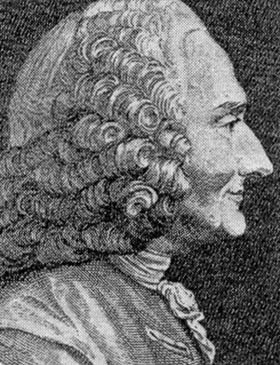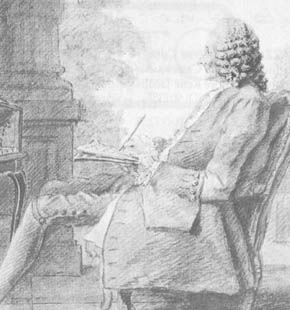French composer and theorist. He probably received his earliest musical instruction from his father, an organist at St. Etienne, Dijon; attended the Jesuit Collège des Godrans, and at 18 went to Milan for a few months. In January 1702 he was temporarily appointed maître de musique at the Cathedral of Notre Dame des Doms, Avignon; by May he had begun a long-term contract as organist at Clermont Cathedral. He moved to Paris by 1706, published his Premier livre de pièces de clavecin (Paris, 1706) and was organist at the Jesuit College in the rue Saint-Jacques and at the Mercederians of rue du Chaume. He returned to Dijon in 1709 to succeed his father at Notre Dame; by 1713 he was organist at the Jacobins in Lyons, and finally returned to Clermont Cathedral in 1715. In 1722 or 1723 he went to Paris for the second time, publishing his second and third harpsichord books (1724 and 1728) there as well as his Traité de l'harmonie (1722) and Nouveau système de musique théorique (1726). By 1732 he was organist at St. Croix-de-la-Bretonnerie and in 1736 at the Jesuit novitiate.

The two theoretical works, along with some polemical exchanges in the Mercure de France (the other participant probably being Montéclair), established his reputation as a theorist, but Rameau also wanted to write for the stage. His operatic debut took place during his 50th year: Hippolyte et Aricie was given at the Opéra in 1733. Rameau began working with Voltaire on Samson, but the project was abandoned. In 1735 his opera-ballet Les Indes galantes was performed, followed in 1737 by his masterpiece Castor et Pollux; his major theoretical work dating from this time was the Génération harmonique (Paris, 1737), submitted to and favorably received by the Académie royale des Sciences. From 1745 on, more than half of Rameau's stage works were written for court premieres. In 1745 alone three of Rameau's compositions were written for the court, including two collaborations with Voltaire (La pri ncesse de Navarre and Le temple de la Gloire ); 1750 saw the publication of his Démonstration du principe de I'harmonie, written in collaboration with Denis Diderot (Paris, 1750). After 1752 his operatic activity, apart from the major works Les Paladins and Les Boréades, slackened; at the same time he produced some important theoretical works, including the Observations sur notre instinct pour la musique. His theories became widely disseminated with the publication of D'Alembert's lucid book Éléments de musique théorique et pratique (1752), translated into German by Marpurg (1757).

Rameau is regarded, along with Lully and Gluck, as one of the principal masters of pre-Revolutionary French opera. His stage works comprise many genres, including the tragédie lyrique, the comédie lyrique, the opéra-ballet, the comédie-ballet, the pastorale, the acte de ballet, and the divertissement, as well as incidental music. His harpsichord publications are particularly fine and circulated widely in the 18th century. No less important are his theoretical works, in which he attempted to reduce music to a science. He argued that all music is founded on harmony, and that all chords can be derived from the perfect triad (major or minor, the source of consonance) or the 7th chord (the source of dissonance); in addition, he formulated the idea of harmonic inversion and invented the concept of a fundamental bass, a sequence of roots, present or not, that are distinct from the thorough bass.
Works:
Dramatic. Hippolyte et Aricie (1733); Les Indes galantes (1735); Castor et Pollux (1737); Les fêtes d'Hébé, ou Les talents lyriques (1739);
Dardanus (1739); La princesse de Navarre (1745); Platée (1745); Les
fêtes de Polymnie (1745); Le temple de la Gloire (1745); Les fêtes
de I'Hymen et de I'Amour ou Les dieux d'Egypte (1747); Zaïs (1748);
Pigmalion (1748); Les surprises de l'Amour (1748); Naïs (1749); Zoroastre (1749); La guirlande, ou Les fleurs enchantées (1751); Acante et
Céphise, ou La sympathie (1751); Daphnis et Eglé (1753); Les
sibarites (1753); La naissance d'Osiris (1754); Anacréon I (1754);
Anacréon II (1757); Les Paladins (1760).
Cantatas. Thétis (ca. 1715-18); Aquilon et Orithie (ca. 1715-19); L'impatience (ca. 1715-22); Les amants trahis (by 1721); Orphée (by 1721); Le berger fidèle (by 1728); Cantate pour le jour de la [fête de] Saint Louis (ca. 1745); Médée (ca. 1715-22).
Solo keyboard. Premier livre de pièces de clavecin (Paris, 1706); Pièces de clavessin avec une methode pour la mechanique des doigts (Paris, 1724); Nouvelles suites de pièces de clavecin (Paris, ca. 1729-30); Les Indes galantes (Paris, ca. 1736); five pieces arranged for solo harpsichord in Pièces de clavecin en concerts (Paris, 1741); La Dauphine (1747?); Les petits marteaux (before 1754?).
Other instrumental. Pièces de clavecin en concerts, harpsichord, violin/flute, bass viol/cello (Paris, 1741).